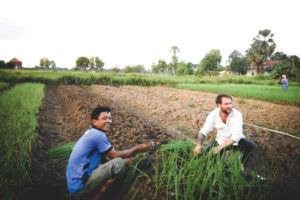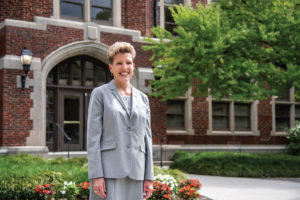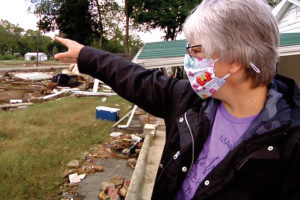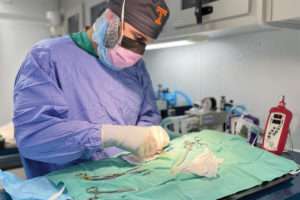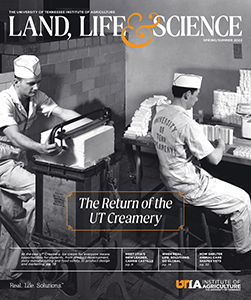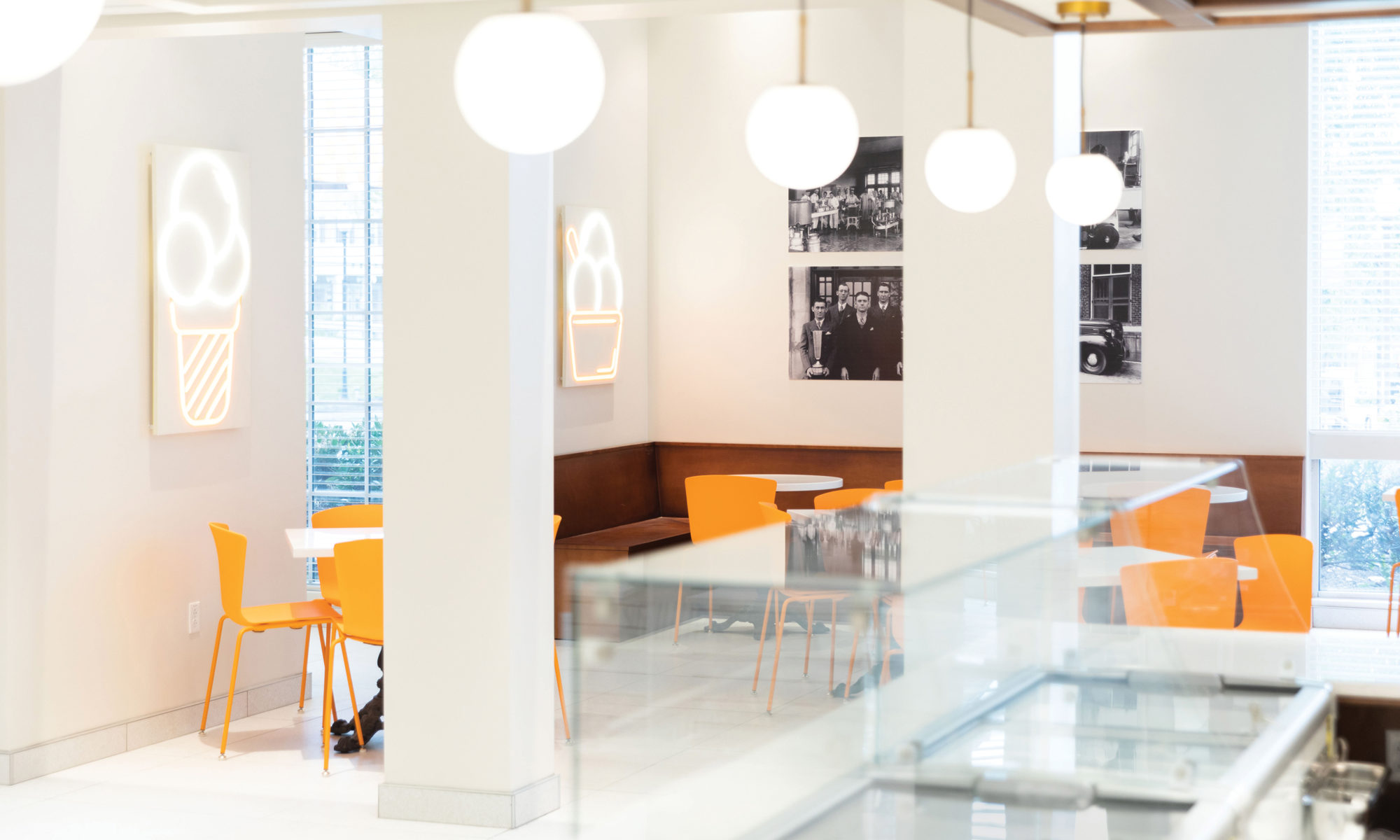
UT Creamery to Offer Students Menu of Hands-on Learning
Editor’s note: Please visit the UT Creamery website for updated information.
Clay Johnson is a food science graduate with a penchant for tasting, and making, ice cream.
Johnson (BS, food science, ’21), an assistant coach of the Department of Food Science’s award-winning dairy judging team, spent the summer and fall of 2021 helping with the initial set up of the university’s new Creamery. He worked side by side with Creamery manager Nathan Miller to research the finer points of making ice cream, learn to use equipment, and develop custom recipes.
It was a sweet experience in more ways than one.
“Making ice cream is fun,” Johnson says. “Being on the ground floor of a new thing is fun.”
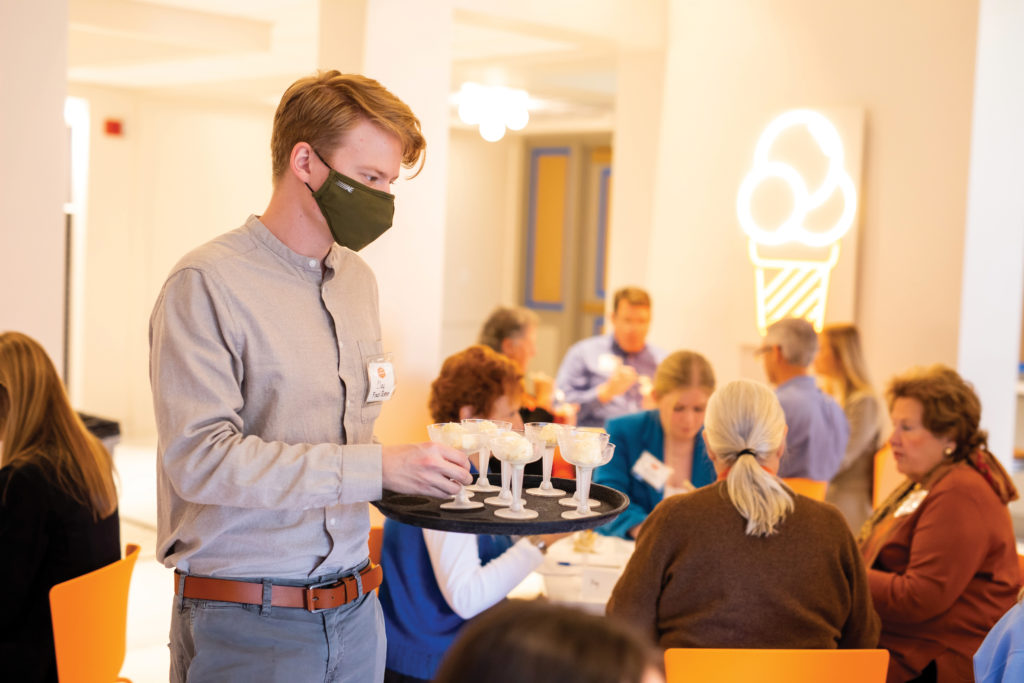
The new UT Creamery—a combined effort of the University of Tennessee Institute of Agriculture, the Herbert College of Agriculture, and the College of Education, Health and Human Sciences—is expected to open in this year. It will include an ice cream making facility in the Food Science Building on River Drive as well as an ice cream shop and boutique in the UT Culinary Institute and Creamery building at 2712 Neyland Drive (the old UT Visitors Center).
Using an ice cream base mix that’s made, in part, with milk from UT’s dairy herd, the UT Creamery will be as close to a farm-to-scoop operation as it can be at this point. Just as importantly, the Creamery will offer hands-on experience for many UT students, like Johnson.
“We value experiential learning as an essential part of educating our students and giving them the complete toolkit to enable them to thrive in their chosen profession,” says Caula Beyl, dean of the Herbert College of Agriculture. “Working in the Creamery will provide that experience for students of many majors by offering real-life experience in agricultural business management, food safety, food production, product development, taste testing, marketing, packaging, and retail sales. Few colleges can offer such a start-to-finish, hands-on application of learning like this. Our students will emerge with the confidence and expertise gleaned from this approach.”
HISTORY REVISITED
In bringing back its Creamery, UT is resurrecting a beloved piece of its history.
The UT Cooperative Creamery was established in 1915 to train students and encourage interest in the dairying profession. In its heyday, it purchased raw dairy products from local farms and produced ice cream, cheese, cottage cheese, milk, and butter which it sold on site and delivered to customers.

Tommy Burch (BS, dairy manufacturing,’66) came on board in 1984 and managed the Creamery until it closed in 1989.
In those final years, the Creamery made whole, 2 percent, skim, and chocolate milk that was packaged in pints and quarts, as well as five-gallon plastic bags for cafeteria dispensers and little cartons for vending machines, Burch says. The Creamery provided milk to UT Medical Center, campus cafeterias, and the public. It also made cheddar cheese and produced various flavors of ice cream packed into three-gallon containers for the cafeterias and five-ounce cups for the hospital.
As for ice cream, the Creamery always made the basics—vanilla, chocolate, and strawberry. In addition, it produced a rotating list of specialty flavors, such as butter pecan, peach (packed in five-ounce cups for UT’s employee picnic), and black raspberry (a favorite at the faculty club). During the holidays, Burch made peppermint, eggnog, and pistachio ice cream.
The work was demanding and sometimes required him to work twelve-hour days to ensure the hospital got its milk and ice cream. Nonetheless, Burch says, “I loved making ice cream.”
The UT Creamery closed in 1989 due to economic constraints and changing consumer demands. A few years later, UT renovated the Dairy Manufacturing Building into what is now the Food Safety and Processing Building on River Drive.
BRINGING BACK AN ICON
“Ever since the old Creamery closed, people wanted it to reopen. And in 2013, the conversation about bringing back the Creamery started in earnest,” says Jean Hulsey, director of creative services for UTIA’s Office of Marketing and Communications.
In 2013, as a first step, the Department of Food Science partnered with Sweetwater Valley Farm to produce All Vol Cheese. Students began interning at the farm to learn the art of cheesemaking, marketing the cheese online, and selling it on campus.
Now, nine years later, All Vol Cheese has expanded to five varieties: Torchbearer Jalapeño Cheddar, Smokey’s Smoked Gouda, Game Day Sharp Cheddar, Checkerboard Mild Cheddar, and Power T Cheese (a combination of orange and white mild cheddar molded into a Power T design).
But leaders from the Institute of Agriculture and both colleges were already thinking well beyond cheese.
Bringing back the UT Creamery—starting with an ice cream production facility and a storefront ice cream parlor—seemed like an ideal way for agriculture and retail to come together to benefit UT student experiential learning, add value by creating consumer-ready dairy products, and spotlight the importance of the retail side of the business. The storefront shop would provide an ideal venue for Rocky Top Institute student fellows in the Department of Retail, Hospitality and Tourism Management to learn real-time retail business and management skills.
The Rocky Top Institute, launched in 2011, is a partnership between UT and the family of Felice and Boudleaux Bryant (the writers of “Rocky Top”) to develop a brand of student-created merchandise. Through the Institute, students already get hands-on experience in product development, brand management, marketing, and sales.
Like Beyl, College of Education, Health and Human Sciences (CEHHS) Dean Ellen McIntyre is enthusiastic about the possibilities.
“Students will get authentic work experiences that will both enhance the skills learned in the program and put them to immediate use to serve the customers,” McIntyre says. “The Creamery will add to our already strong reputation in both retail and hospitality.”
View a timeline of the Creamery’s history.
ENTER THE COWGIRLS
While university leaders had the will to bring back the Creamery, they needed help finding the financial way.
Last year, UT alumnae Sue Conley and Peggy Smith of California—who created the renowned Cowgirl Creamery brand—agreed to provide funding that got the project churning.
Conley (BS, political science ’75) and Smith, who studied history and American studies, became friends at UT. After college, the two road-tripped to California where both established careers in the burgeoning food mecca of San Francisco. In the 1990s, they joined forces in Point Reyes Station, north of San Francisco, where they launched Tomales Bay Foods, a wholesale distribution business that focused on making the area’s farm and dairy products mainstays in Bay Area restaurant kitchens. They also began making artisanal cheeses using local dairy milk, an effort that became Cowgirl Creamery, now a national brand with retail stores and cafes across the country.
In 2017, they sold Cowgirl Creamery to Emmi, a Swiss dairy company, and in 2021 they fully retired from the operation.
The Cowgirls have been longtime supporters of their alma mater. For three years, they offered summer internships at the Cowgirl Creamery for agriculture students interested in cheesemaking and retail students interested in the business side of the operation. For another two years, they helped launch Great Smoky Mountain Food Days, an event sponsored by the UT Department of Retail, Hospitality and Tourism Management and East Tennessee PBS to highlight the region’s food and culture through programs and demonstrations.
Since the Creamery would be an interdisciplinary effort, advancement officials from both sides—Tom Looney, director of advancement for the Institute of Agriculture, and Randy Atkins, director of advancement for CEHHS—collaborated on a proposal. Brian Broyles, executive director of regional advancement, presented it to Smith and Conley, and they loved it.
“Very early on, it was evident that Peg and Sue wanted to help their alma mater in a way that would be meaningful to them while also providing experiential learning opportunities for UT students,” Broyles says. “The idea to resurrect the UT Creamery in Knoxville was one that they had given a lot of thought to, and their vision has been the driving force behind this unique collaboration. They deserve all the credit for being so visionary and forward-thinking.”

Conley says the UT Creamery project is exciting because it will benefit students and the university while also supporting the local dairy industry and other local businesses.
The Cowgirls are providing seed money to help fund the Creamery until it can become self-sustaining; their gifts will fund the salaries of both Miller and Myra Loveday, the director of creamery retail strategy, for three to five years.
“The team is really good,” Conley says. “Nathan is a talented and determined production leader. Myra is an inspirational marketer and creative thinker. The students who work with the Creamery will be fortunate to have the opportunity to learn from these two.”
Conley hopes the Creamery opens students’ eyes to exciting career options. “They may be only thinking of the more traditional avenues for food businesses,” she says. “They’re not thinking of being a cheesemaker or a bread baker.”
Beyl says the Creamery represents “collaboration at its best.”
“Sue Conley and Peggy Smith were instrumental in making this dream a reality through their generosity,” Beyl says. “They saw the potential of partnering the College of Education, Health and Human Sciences with the Herbert College of Agriculture to bring the best of both worlds to the Creamery outlet. Marketing products, developing branded merchandise, and managing the retail outlet will be the focus of retail students and production of the ice cream, cheese, and other edible products will be the focus of food science students.”
The Creamery represents “collaboration at its best.”
Dean Caula Beyl
SETTING UP SHOP
Despite a few slowdowns due to the pandemic and related supply chain issues, the Creamery is coming closer to opening its doors.
A portion of the second floor of the Food Science Building has been renovated into the ice cream production facility, complete with truck bays, cooking and processing equipment, walk-in refrigerators and freezers, and an observation window where visitors can watch the ice cream-making process.
When customers walk into the 1,500-square-foot retail shop a few blocks away, they will be greeted by an aura of days gone by—a black-and-white checkered tile floor, brass and mercury glass accents, and historical photos of the UT Creamery.
Hulsey, who helped shepherd the project from conception to reality, says her team in Marketing and Communications discussed various names for the creamery but ultimately decided to stay true to history, calling it simply the UT Creamery. They designed a nostalgic, yet timeless, logo and incorporated the tagline “Made in Tennessee.”
Dollar and Ewers Architecture Inc. of Knoxville and Z Creative Group of Corryton did the design work. UT Facilities Services did much of the construction work.
“The location of the Creamery storefront is ideal not only for visitors to the campus but also for those walking along the Tennessee River on the greenway,” Beyl says. “Eventually, I hope to see an outdoor seating area that takes in the breathtaking view of the river from the higher vantage point of the Creamery storefront and creates an outdoor space where students can refresh and recharge.”
RECIPE FOR SUCCESS
While construction of the Creamery’s production facility and storefront have been under way, Miller and Johnson have been busy learning the nuances of ice cream making.
Miller says the Creamery will purchase its ice cream base mix from Weigel’s, the East Tennessee convenience store chain, which gets its milk for that base mix from Tennessee dairies, including UT’s dairy at the East Tennessee AgResearch and Education Center’s Little River Animal and Environmental Unit in Walland in Blount County.
This means UT students will be involved with the Creamery all the way back to the farm; as of January 2022, the Little River unit had two graduate students as full-time staff members and was seeking a part-time undergraduate worker. Each year, undergraduate interns from the Herbert College of Agriculture rotate through the dairy operation to get hands-on experience in dairy research management.
To make ice cream, the base mix is blended with non-fat milk solids, sugars, and stabilizers. After this mixture cooks and then rests, flavors and yummy extras, like cookie dough, chips, mint pieces, or sprinkles, are added. This batter then churns in a barrel freezer until it reaches soft-serve consistency. A minus-10-degree Fahrenheit “blast freezer” transforms it into a smooth, scoopable delicacy.
Johnson and Miller have experimented with vanillas from Tahiti, Madagascar, and the Bourbon Islands. They’re still tweaking the chocolate recipe, too.
“The easiest, the simplest, the most classic flavors are the hardest to make,” Johnson says.
By contrast, more exotic flavors, such as orange creamsicle or pumpkin pie, cause little angst.
“It’s tough to make those bad,” Johnson says. “But with vanilla and chocolate, there’s not much to distract people from imperfections.”
Miller says the Creamery will produce one batch at a time, several batches a day. In time, he expects the shop to offer up to sixteen flavors at a time. The shop will sell ice cream by the dish and cone, including homemade waffle cones, and by the pint. It will serve milkshakes and coffee chillers, too.
In addition to the classics—vanilla, chocolate, and strawberry—the Creamery will offer a changing lineup of specialty flavors. Expect to see historic favorites, like black raspberry, praline pecan, and peach; traditional holiday treats, like peppermint and eggnog; and on-trend flavors. The Creamery team also is working on an orange sherbet, which some have dubbed “Herbert Sherbet,” in a nod to the Herbert College of Agriculture.
New flavors will likely go through the Food Science sensory lab where UT faculty, staff, and student taste-testers will provide input to help fine-tune the recipes.
Miller says he expects to employ five to eight students as part-time paid interns who will work in the production process.
Loveday will oversee nine to fourteen juniors and seniors serving as Rocky Top Institute fellows who create UT- and Creamery-themed clothing, drinkware, tailgating supplies, and commemorative and collectible items. They come up with concepts and prototypes, arrange manufacturing, and oversee all aspects of merchandising. These students will consult with Miller’s team to brainstorm and name new flavors, study the wants and needs of customers, and market the ice cream.
The Rocky Top Institute fellows will help train and manage three to five students hired to staff the ice cream retail shop.
Food science students will learn about retail while retail students learn about food production.
The cross-training “is going to be really advantageous,” Loveday says.
Miller agrees: While ice cream and cool merchandise may be its visible wares, the Creamery’s real selling point is the wide menu of hands-on learning experiences it will offer students.
“Ice cream is really just the vector for the experience the students are getting,” he says.
Beyl says she imagines campus visitors and prospective students capping off their campus visits by stopping at the Creamery. While enjoying a refreshing treat, they’ll get a look at some of the great things happening at UT.
“The Creamery will be an iconic attraction on the university campus that will evoke not only the nostalgia of the College when it still had a creamery, but also celebrate what cutting-edge agriculture has evolved into with advancements in product development, production, and food safety,” she says.
And that, those involved in the Creamery’s return say, is the cherry on top.

Explore More on
Cover Articles
MORE FROM THIS ISSUE



